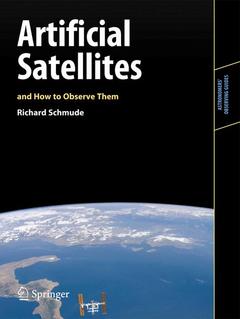Description
Artificial Satellites and How to Observe Them, 2012
Astronomers' Observing Guides Series
Author: Schmude, Jr. Richard
Language: English
Subject for Artificial Satellites and How to Observe Them:
36.91 €
In Print (Delivery period: 15 days).
Add to cartSupport: Print on demand
Description
/li>Contents
/li>Biography
/li>Comment
/li>
Every amateur astronomer - and many non-astronomers - will be familiar with seeing a "star" that shows that characteristic steady slide across the starry background of the sky. Artificial satellites can be seen any night, and some as bright as the planets. But how many of us can identify which satellites or spent launch vehicle casing we are seeing?
Artificial Satellites and How to Observe Them describes all the different satellites that can be observed without optical aid, including of course the International Space Station and the many spy satellites operated by different nations. Richard Schmude looks at them in detail and describes how they can be observed by amateurs, how to recognize them, and even how to predict their orbits.
Artificial satellites have changed since the beginning of the millenium. Several additional countries have launched them. And amateur astronomers have utilized digital cameras in order to image satellites to a resolution of about three feet. This book describes how to recognize, observe, and image satellites. Examples of recent images and how they were made are given. It also offers up-to-date descriptions of the many satellites that are orbiting the Earth and other celestial bodies. Readers can learn how satellites impact our day-to-day lives. In short, Artificial Satellites and How to Observe Them is a detailed and up-to-date overview of artificial satellites and how to study them in the night sky.
Preface.- Chapter 1: Satellite Basics.- Chapter 2: Scientific Satellite Spacecraft.- Chapter 3: Earth Observing and Weather Satellites.- Chapter 4: Observing Artificial Satellites.- Chapter 5: Imaging Artificial Satellites and Doing Research.- Chapter 6: Computation of Eclipse Times.- Sources.- Index.
Dr. Richard Willis Schmude, Jr., was born in Washington D.C., and attended public schools in Cabin John, Maryland; Los Angeles, California; and Houston, Texas. He started his college career at North Harris County College and graduated from Texas A&M University with a Bachelor of Arts degree in Chemistry. Later, he obtained a Master of Science degree in Chemistry, a Bachelor of Arts degree in Physics, and a Ph.D. in Physical Chemistry, all from Texas A&M University. He worked at NALCO Chemical Company as a graduate co-op student and at Los Alamos National Laboratory as a graduate research assistant.
Since 1994, Richard has taught astronomy, chemistry, and other science classes at Gordon college in Barnesville, Georgia. He is a tenured professor at this college and continue to teach his students (and others) in these area. He has published over 100 scientific papers in many different journals and has given over 500 talks, telescope viewing sessions and workshops to over 25,000 people.
These books may interest you

Sky Alert!When Satellites Fail 31.64 €



